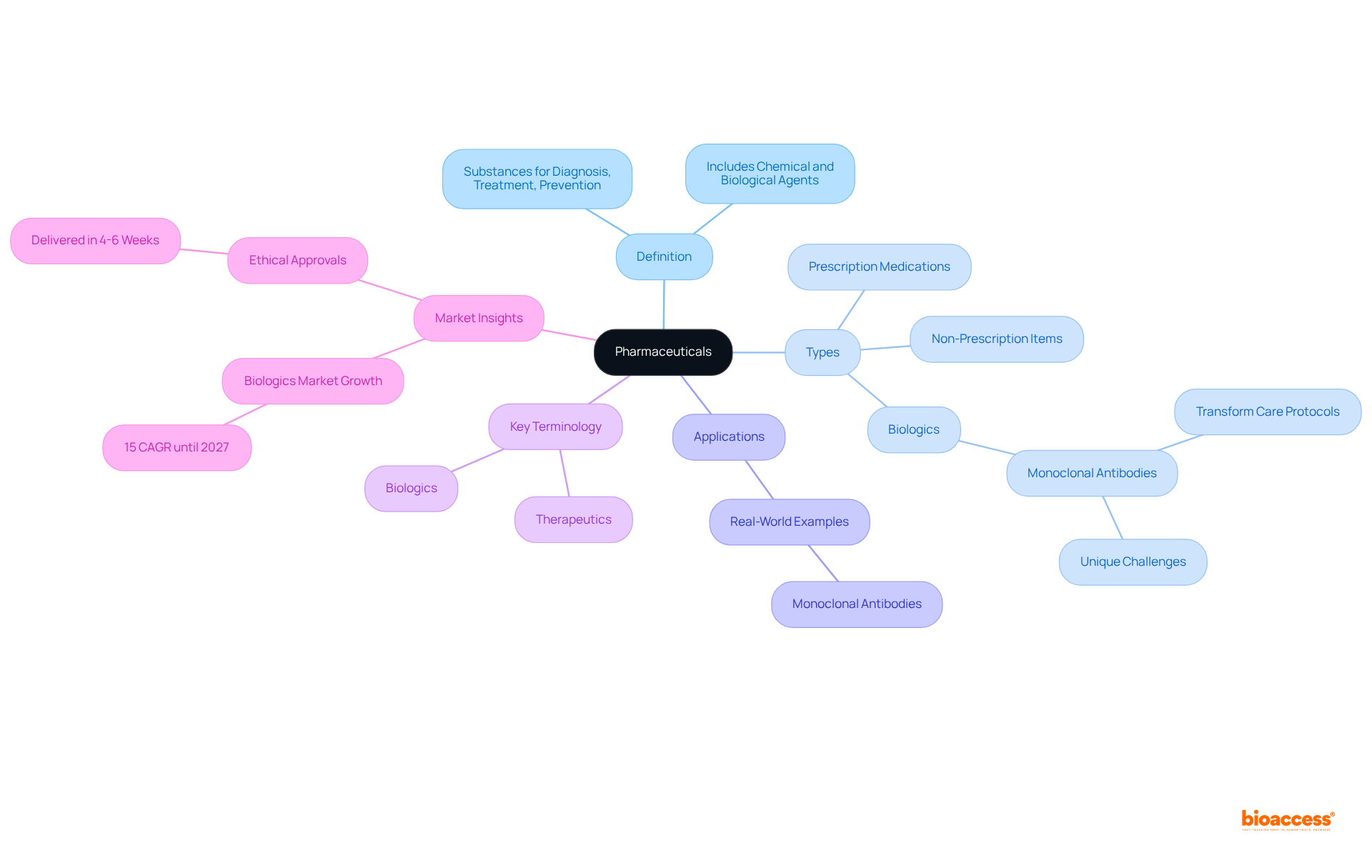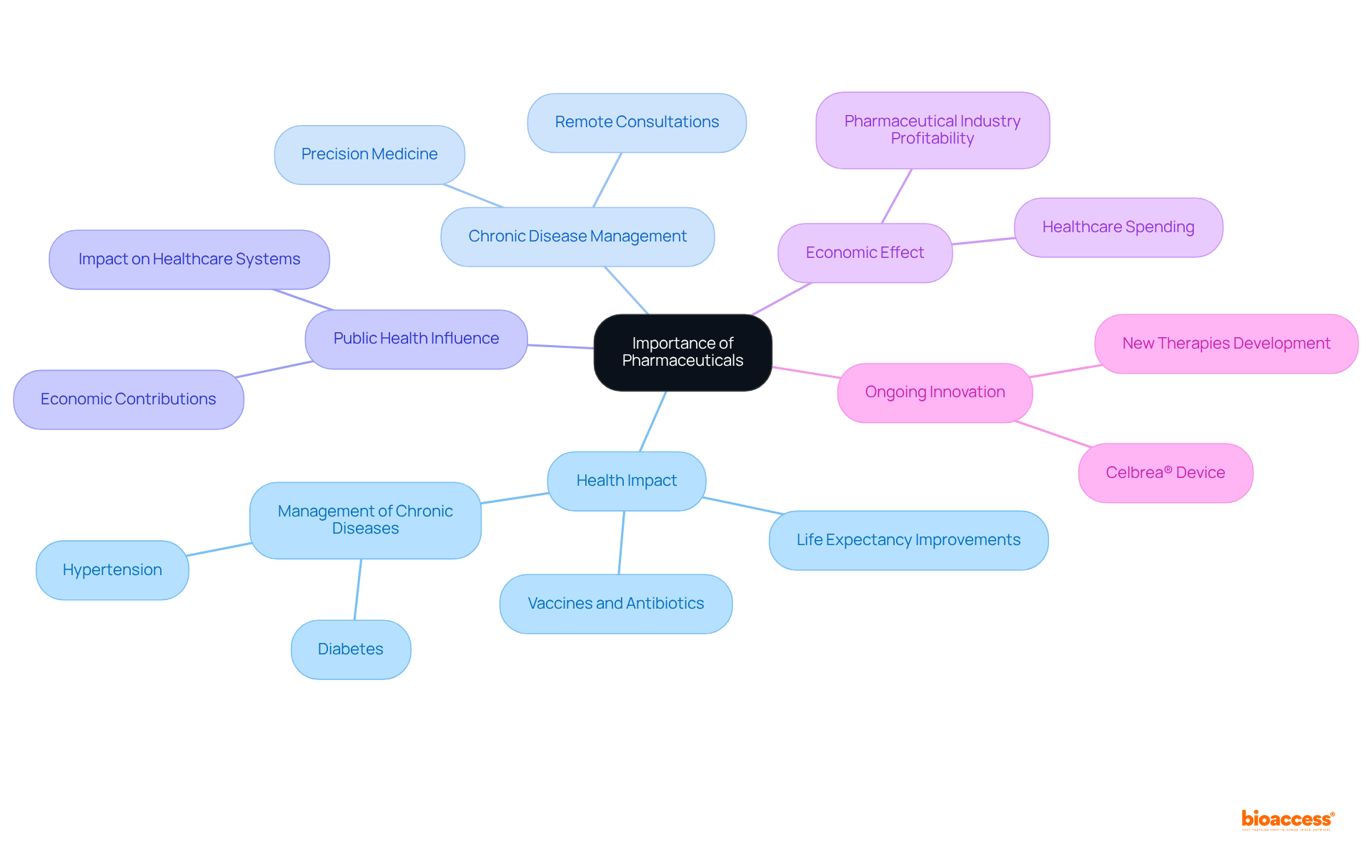


Pharmaceuticals are defined as substances utilized for the diagnosis, treatment, or prevention of diseases, encompassing a broad spectrum of products ranging from simple medications to complex biologics. This article substantiates this definition by detailing the historical evolution, classifications, and significant impact of pharmaceuticals on healthcare. It emphasizes their critical role in enhancing patient outcomes and addressing various health conditions, underscoring the necessity of these substances in modern medicine.
Pharmaceuticals play a pivotal role in modern healthcare, serving as the backbone for diagnosing, treating, and preventing a myriad of medical conditions. With a rich history that spans from ancient remedies to groundbreaking discoveries like penicillin, the evolution of pharmaceuticals reflects significant advancements in medical science and technology. However, as the industry continues to grow and diversify, questions arise about the implications of this progress—how do various classifications of pharmaceuticals impact patient care and public health? This exploration delves into the definition, history, and types of pharmaceuticals, uncovering their essential contributions and the challenges that lie ahead in the quest for effective healthcare solutions.
What is a pharmaceutical is defined as substances utilized for the diagnosis, treatment, or prevention of diseases and medical conditions. They encompass a wide range of products, including prescription medications, non-prescription items, and biologics. This term covers everything from simple chemical compounds to intricate biologics, incorporating both chemical and biological agents.
Understanding what is a pharmaceutical, along with the fundamental ideas and language related to medications, is essential for successfully navigating the drug landscape. This knowledge is vital for discussions surrounding drug development, regulatory processes, and therapeutic applications. Notably, the biologics market is projected to grow significantly, underscoring the increasing significance of biologics in modern medicine.
Real-world examples illustrate the diverse applications of pharmaceuticals. For instance, monoclonal antibodies (mAbs) have transformed care protocols for various conditions; however, they also pose unique challenges that necessitate innovative strategies.
At bioaccess®, we specialize in early-phase clinical research services, offering comprehensive support that includes feasibility studies, site selection, compliance reviews, trial setup, import permits, project management, and reporting. Our expertise enables us to provide ethical approvals rapidly, thereby improving the efficiency of development processes.
Key terminology in the medicine field includes terms like 'biologics,' referring to products derived from living organisms, and 'therapeutics,' denoting treatments aimed at alleviating symptoms or curing diseases, which helps clarify what is a pharmaceutical. Grasping these terms not only assists in effective communication but also enhances the ability to navigate the intricacies of medication development and market access.
In summary, a solid foundation in medication terminology is crucial for professionals in the field, as it empowers them to navigate the complexities of drug development and contribute to the advancement of healthcare solutions.

The history of medicine traces back to ancient societies, where natural substances formed the foundation of healing practices. A pivotal moment in this evolution occurred in 1928 with Alexander Fleming's discovery of penicillin, which heralded the antibiotic era and revolutionized medical treatment. This breakthrough not only established the groundwork for modern antibiotics but also significantly influenced the pharmaceutical landscape, leading to a projected compound annual growth rate of 15% in the biologics market until 2027.
Fleming's fortunate accident with mold contaminating a Petri dish of Staphylococci showcased the potential of antibiotics to eradicate bacteria, marking a substantial advancement in medical science. The establishment of regulatory organizations, such as the FDA in the early 20th century, further transformed the industry by enforcing standards for safety and efficacy. Over the decades, technological advancements have spurred the development of innovative therapies, including monoclonal antibodies and gene therapies, redefining treatment options for a myriad of diseases.
However, the improper use of antibiotics poses significant dangers, resulting in antimicrobial resistance that can undermine the effectiveness of these lifesaving medications. As emphasized by the National Center for Emerging and Zoonotic Infectious Diseases, the appropriate use of antibiotics is crucial to combat this resistance and ensure their availability for future generations. These milestones underscore the dynamic nature of what is a pharmaceutical, illustrating a continuous journey from ancient remedies to cutting-edge medical solutions.

Pharmaceuticals can be classified into several categories based on their chemical structure, mechanism of action, and therapeutic use. The primary classifications include:
Small Molecule Drugs: These low molecular weight compounds can easily penetrate cells and interact with specific biological targets. Common examples include aspirin and statins, which are widely used for pain relief and cholesterol management, respectively. Industry specialists observe that small molecule compounds usually possess well-defined chemical structures, enabling accurate targeting of illness mechanisms.
Biologics: Derived from living organisms, biologics encompass a range of products, including vaccines, blood products, and monoclonal antibodies. These therapies are particularly effective in treating complex diseases such as cancer and autoimmune disorders. The biologics market is projected to grow significantly, with a compound annual growth rate of 15% until 2027, reflecting the increasing reliance on these advanced therapies.
Generics: Generics are replicas of brand-name medications that are chemically identical but sold at reduced prices once the original patent lapses. In 2022, the FDA approved or tentatively approved 914 Abbreviated New Drug Applications (ANDAs), highlighting the prevalence of generics in the pharmaceutical market. The competition from generics is crucial, as it generates billions in savings for consumers and the healthcare system, with estimates indicating approximately $53.3 billion saved in the first year following the approval of new generics in recent years. As Susan Rosencrance, Ph.D., Acting Director of the Office of Generic Medicines, stated, "Generic medication competition provides tremendous public health advantages for the United States by assisting in reducing costs and enhancing access to necessary treatments for American patients."
Orphan Medications: Created to address rare conditions, orphan medications frequently obtain unique incentives for development because of their restricted market potential. These drugs play an essential role in addressing unmet medical needs, offering solutions for conditions that might otherwise be overlooked due to low profitability.
Each type of pharmaceutical is vital in addressing various health conditions and improving patient outcomes, highlighting what is a pharmaceutical's importance in terms of innovation and accessibility in the industry.

To understand what is a pharmaceutical, one must recognize that pharmaceuticals are essential to modern healthcare, serving as vital instruments for the prevention, diagnosis, and treatment of illnesses. Their development has ushered in remarkable improvements in life expectancy and quality of life for millions worldwide.
For example, effective medications have transformed the management of chronic diseases such as diabetes and hypertension, while vaccines and antibiotics have played a crucial role in fighting infectious diseases. Recent statistics reveal that advancements in medicine have resulted in a significant increase in life expectancy, with estimates suggesting that contemporary treatments have extended average lifespans by several years.
Furthermore, ongoing research and innovation within the medical sector continue to produce new therapies that meet unmet medical needs, thereby enhancing patient care. A noteworthy illustration of this is the collaboration between bioaccess™ and Welwaze Medical Inc. for the launch of the Celbrea® medical device in Colombia, highlighting the importance of regulatory access and market entry strategies in broadening healthcare solutions.
The impact of what is a pharmaceutical transcends individual health, profoundly influencing public health systems and economies globally, thereby underscoring their critical role in chronic disease management and overall societal well-being.

Pharmaceuticals play an indispensable role in contemporary healthcare, serving as the foundation for diagnosing, treating, and preventing a myriad of health conditions. This article has delved into the multifaceted nature of pharmaceuticals, exploring their definitions, historical evolution, classifications, and their critical impact on health and society. Understanding these elements is vital for navigating the complexities of the pharmaceutical landscape, which encompasses everything from small molecule drugs to innovative biologics.
Key insights discussed include:
Furthermore, the ongoing advancements in pharmaceuticals continue to enhance patient care and public health, demonstrating their profound influence on life expectancy and quality of life.
The significance of pharmaceuticals extends beyond individual health; they are integral to the functioning of public health systems and economies worldwide. As the pharmaceutical landscape continues to evolve, staying informed about its developments is crucial for professionals and the public alike. Embracing a deeper understanding of pharmaceuticals can empower individuals to engage more effectively in discussions about healthcare solutions, advocate for better access to medications, and ultimately contribute to a healthier society.
What is a pharmaceutical?
A pharmaceutical is defined as substances utilized for the diagnosis, treatment, or prevention of diseases and medical conditions. This includes prescription medications, non-prescription items, and biologics.
What types of products are included under pharmaceuticals?
Pharmaceuticals encompass a wide range of products, including simple chemical compounds, intricate biologics, prescription medications, and non-prescription items.
Why is understanding pharmaceuticals important?
Understanding pharmaceuticals is essential for navigating the drug landscape, facilitating discussions on drug development, regulatory processes, and therapeutic applications.
What is the significance of biologics in modern medicine?
The biologics market is projected to grow significantly, highlighting the increasing importance of biologics in modern medicine.
Can you provide an example of a pharmaceutical and its impact?
Monoclonal antibodies (mAbs) are an example of pharmaceuticals that have transformed care protocols for various conditions, although they also present unique challenges that require innovative strategies.
What services does bioaccess® offer in relation to pharmaceuticals?
Bioaccess® specializes in early-phase clinical research services, providing support such as feasibility studies, site selection, compliance reviews, trial setup, import permits, project management, and reporting.
What is meant by 'biologics' and 'therapeutics' in the context of pharmaceuticals?
'Biologics' refers to products derived from living organisms, while 'therapeutics' denotes treatments aimed at alleviating symptoms or curing diseases.
How does knowledge of pharmaceutical terminology benefit professionals in the field?
A solid foundation in medication terminology enhances effective communication and empowers professionals to navigate the complexities of drug development and contribute to healthcare solutions.